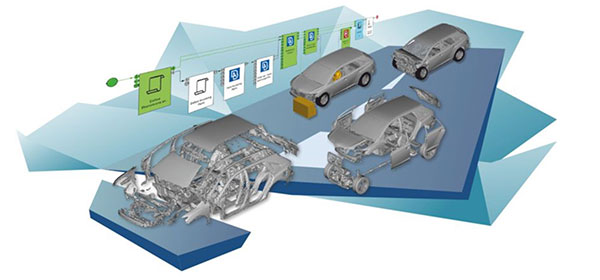
SPDRM is a solution for CAE workflow management. Image courtesy of BETA CAE Systems.
Latest News
August 22, 2023
This version of SPDRM v1.10.0 from BETA CAE Systems introduces enhancements for multi-site installations. Up to now, in multi-site SPDRM installations with more than one remote sites, the central site was always the mediator of all file exchanges between remote sites, i.e., a file created in remote site “A” and requested by remote site “B” should first be transferred from site “A” to the central site, to finally be transferred to remote site “B.”
Targeting to a more efficient and “cost-effective” data transfer among sites, this version introduces “RIOC2RIOC,” an optimized solution that enables site-to-site file transfer. In this implementation the system fetches the data from the nearest remote site, instead of getting them from the central site, speeding up file transfer between neighboring remote sites.
In cloud-based installations, the number of requests and the total size of data transferred from cloud storage to external data centers affect the overall deployment cost. This cost could be reduced by minimizing direct fetching of data from the cloud, by giving priority to external data centers (remote sites) during data transfers.
This solution enables files from a specific remote site to be transferred to the nearest remote site directly, completely avoiding their exposure to the central site. This option could be useful for organizations that use cloud-based central site but must conform to strict information security requirements for the storage of business-critical data on cloud.
On the way toward a cloud-native SPDRM, this version introduces direct integration with Amazon S3 (Amazon Simple Storage Service). Amazon S3 is a scalable and secure cloud-based storage service offered by Amazon Web Services (AWS). It provides developers and businesses with a solution for storing and retrieving vast amounts of data. The integration with Amazon S3 offers a cost-effective storage on cloud, especially for large-scale SPDRM deployments.
Targeting to a lightweight application that will carry out batch jobs with the minimum memory and storage footprint, as well as with faster launching time, this version introduces the PEX (Process EXecutor), that comes as a replacement of the NoGUI Client. This means that the SPDRM NoGUI Client becomes deprecated from this version onward.
For system administrators, this version offers a web interface for the management of users and roles in SPDRM. The SPDRM Administration Page now offers new possibilities in Users Management, in addition to displaying the list of logged-in users and closing the active user sessions, which were already supported in previous versions. More specifically, this version introduces the following additional functionality:
- Create, edit, deactivate/activate users
- Assign roles to a user
- Create/delete roles
- Define role hierarchy
- Add users to a role
- Apply privileges on existing data
- Assign target vault to role
For more product details, click here.
Sources: Press materials received from the company and additional information gleaned from the company’s website.
More BETA CAE Systems Coverage
Subscribe to our FREE magazine, FREE email newsletters or both!
Latest News
About the Author
DE’s editors contribute news and new product announcements to Digital Engineering.
Press releases may be sent to them via [email protected].






